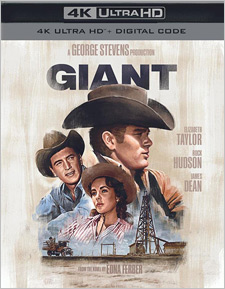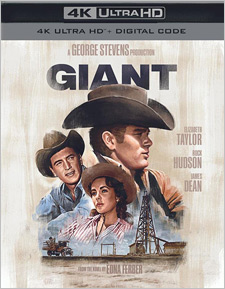Giant (4K UHD Review)

Director
George StevensRelease Date(s)
1956 (June 21, 2022)Studio(s)
Warner Bros. (Warner Home Video)- Film/Program Grade: A
- Video Grade: A-
- Audio Grade: B+
- Extras Grade: B-
Review
Three decades before nighttime soaps like Dallas, Dynasty, and Falcon Crest would dominate network television, director George Stevens laid the groundwork for them with his sprawling 1956 adaptation of Edna Ferber’s equally sprawling 1952 novel Giant. It’s a paradigm of the nighttime soap opera formula: a chronicle of the travails of wealthy businesspeople who are vying with their rivals while simultaneously having to deal with family issues at home. In this case, it’s traditional Texas cattle ranchers vs. the encroachment of Big Oil, with the former represented by Rock Hudson and Elizabeth Taylor as Jordan and Leslie Benedict, and the latter personified by James Dean (in his final role) as Jett Rink. Yet while Benedict vs. Rink may provide the narrative thread that runs in the background through the entire film, it’s the familial elements in Giant that provide its most interesting material, especially in the surprisingly progressive way that it handles racial issues (despite some very regressive makeup on the Mexican characters). The “A” story in Giant may be its engine, but it's the “B” stories that supply the fuel to keep that engine running.
Ferber’s novel had raised a stir in Texas for the way that it portrayed the bigoted treatment of Mexican immigrants by the white residents of the state. The Houston Press even suggested that she should be lynched—which was a strikingly poor choice of phrase in this particular context! The adaptation by Fred Guiol and Ivan Moffat preserves that element of the novel, but they also made a few key changes that arguably improved upon the book. One major change is that they jettisoned Ferber’s unnecessary flashback structure, moving her opening into its proper chronological place in the story, and that move strengthened the overall narrative flow. Yet it's a single minor change that they made to the penultimate scene that’s most significant, as it makes Ferber’s quiet finale work much better than it did in the novel.
While Jordan Benedict is a Texas native, his wife Leslie is an Easterner, and he’s disturbed by the kindness that she shows to the Mexican immigrants that she encounters. Jordan is a product of his environment, and old prejudices die hard. In many ways, Giant is Jordan’s journey from bigotry to a grudgingly Texan kind of acceptance of people who are different from him. Toward the end of the book, Ferber included a scene at a diner where members of Jordan’s family are ejected because of the color of their skin. Jordan wasn’t present in her version, but Guiol and Moffat changed that. They also added a separate Mexican family that faces the wrath of the proprietor, and for the first time in his life, Jordan decides to stand up against prejudice. It’s a crucial moment for his character, one that could have easily devolved into a white savior trope, but Guiol and Moffat wisely didn’t allow the scene to play out in the expected heroic fashion. Instead, Jordan gets to learn the hard way that doing the right thing comes at a price. The only thing that he can really change is himself.
Stevens assembled a magnificent cast for Giant. Hudson, Taylor, and Dean are all superb, and they’re capably assisted by Mercedes McCambridge, Carroll Baker, Dennis Hopper, Chill Wills, Paul Fix, Earl Holliman, Rod Taylor, and many others. Yet despite all of the varied family dynamics at play, it’s the relationship between Jordan and Leslie Benedict that provides the heart of the film. Hudson and Taylor didn't necessarily have conventional chemistry together, at least in the romantic sense, but they did have genuine chemistry when playing a married couple. (While Hudson may not have ended up becoming one of Taylor’s conquests, for obvious reasons, the two became lifelong friends on and off the set, and it shows in the film.) The relationship between Jordan and Leslie matures plausibly as the characters age, with their early differences gradually growing into a real mutual respect for each other. That’s why the alteration to the scene in the diner pays dividends during the final moments. Leslie ends up expressing her admiration for Jordan not for winning the battle, but rather for being willing to lose. That’s the kind of love that only comes from maturity, and from having traveled countless miles together. Leslie recognizes that Jordan still has a long way to go in his own personal journey, but she’ll be there every step of the way—and the final fade out provides the hope that future generations will have an easier time seeing eye to eye.
Cinematographer William C. Mellor shot Giant on 35 mm film using spherical lenses, framed at 1.66:1 for its theatrical release. (While it may have been cropped to 1.85:1 in many theatres, 1.66:1 is the most accurate to what Mellor and Stevens intended.) For this restoration from Warner Bros. and The Film Foundation, the original camera negative and protection RGB separation master positives were scanned at 4K resolution, cleaned up on a frame-by-frame basis, then color corrected in high dynamic range (only HDR10 is included on the disc). While Warner Bros. Motion Picture Imaging did its usual impeccable work, there are challenges with Giant that can never be resolved due to the way that it was originally produced. The biggest problem is the abundance of optical transitions—or to be more precise, the way they were created in 1956.
First-run theatrical prints for Giant were contact printed from the original camera negative, so they were single-strand printed. That means that instead of generating dissolves or wipes on the fly using two separate negative elements, all of the opticals had to be created separately on an optical printer, and then the resulting dupe footage was cut back into the negative for striking release prints. Unfortunately, the decision was made to cut in the full leading and trailing shots that surrounded those transitions, rather than simply cutting in the transitions themselves, so more footage was affected than was necessary. Worse, that dupe footage was poorly produced on early Eastman Color stock, and it’s softer than it should have been. Because of the large quantity of such transitions that Stevens used throughout the film, it involves a substantial amount of Giant’s running time. Film preservationist Robert A. Harris has estimated that 4,028 feet of footage was affected, which amounts to approximately 45 minutes. The negative elements that were used to generate the transitions were discarded, so there’s no possibility of scanning those original negative trims and generating new transitions. Using the problematic dupe elements was unavoidable, regardless of the scanning technology at play.
While it's not quite right to say that this 4K restoration of Giant should be graded on a curve, it still does need to be viewed with a clear understanding of what couldn’t be addressed during the restoration process. Taken as a whole, Giant will never look as pristine as some other restorations of classic films. That said, when the nature of the original production is taken into proper consideration, this is a stunning presentation of the film. The footage that was scanned from the camera negative is pristine, with no signs of damage whatsoever, and it shows a subtle uptick in fine detail compared to the previous Blu-ray release. That's most apparent in the costuming, which features a variety of textures and weaves (especially the jackets worn by the men, like the herringbone pattern worn by Hudson at the beginning of the film). This improvement in detail may be barely perceptible from normal viewing distances, but it's there, and it makes the image seem crisper even without moving closer to the screen. The HDR grade tweaks the colors slightly, but it doesn’t try to reinvent the wheel; it just makes sure that all of the originally available color information is present, and reproduced well. The contrast range is perhaps expanded slightly compared to Blu-ray, but not dramatically so.
In regards to the dupe footage, it looks the best here than it ever has. MPI did what it could to extract as much detail as possible, most notably in terms of improved contrast—the darkest areas of the screen aren’t quite as muddy and washed out as in previous versions. There's still occasional haloing from the printing process, especially when foreground images are framed against the sky (like with the horse at 20:31), but there's little that could be done to remove that. The irony is that while the dupe footage has indeed improved in this version, so has the negative footage, so the differences between the two are as apparent at ever. The good news is that while 45 minutes may seem like a lot of material, Giant is a lengthy film, so that means 156 minutes of the total running time wasn't affected at all. In balance, this restoration is a thing of beauty despite the unavoidable flaws.
Primary audio is offered in English 2.0 mono DTS-HD Master Audio. This audio track was sourced from a 1995 protection copy of the original magnetic elements. Everything sounds as pristine as the image looks, with little in the way of noise, distortion, or other artifacts. Dimitri Tiomkin’s score rings clear, and there's even a bit of bass rumble during the oil gusher scenes. (It's hardly Sensurround, but it's there.) Additional audio options include French, German, Italian, Spanish (Spain), and Spanish (Latin America) 1.0 mono Dolby Digital. Subtitles include English SDH, French, German SDH, Italian SDH, Spanish (Spain), Dutch, and Spanish (Latin America).
Warner Bros.’ 4K Ultra HD release of Giant is UHD only—it doesn't include a Blu-ray copy of the film, but it offers a Digital code on a paper insert tucked inside the case. Only one of the extras from the previous Blu-ray/DVD combo pack has been carried forward:
- Audio Commentary by George Stevens, Jr., Ivan Moffat, and Stephen Farber
This commentary was originally included on the 2003 DVD release of Giant. Moffat died in 2002, so it’s not clear when the track was actually recorded (but it doesn’t appear to have been included on any LaserDisc versions). Farber acts as a moderator, but George Stevens, Jr. takes the lead early—he’s long been the curator and tireless promoter of his father’s estate (he also served as an uncredited production assistant on Giant). Moffat still has plenty of interesting contributions, and notes that the entire script was shot as written. There are some gaps throughout, and even some repetition, but this is still a valuable document of the thoughts from the people who were involved with making the film.
The extras missing from this release are substantial: the introduction from George Stevens, Jr.; the documentaries George Stevens: Filmmakers Who Knew Him, Memories of Giant, Return to Giant, and George Stevens: A Filmmaker’s Journey; the New York, Hollywood, and Texas premiere footage; the two Behind the Cameras segments; the trailers; and all of the stills galleries. If you have either the standalone Giant Blu-ray or the James Dean Ultimate Collector’s Edition set, needless to say, you're going to want to hang onto it. If you do have the Blu-ray, is it worth the upgrade? Everyone’s mileage will vary, but this is a lovely release of a classic film. It's impossible for anyone to keep up with all of the great physical media releases these days, but hopefully this stellar Warner Bros. release makes your short list.
- Stephen Bjork
(You can follow Stephen on social media at these links: Twitter and Facebook.)

